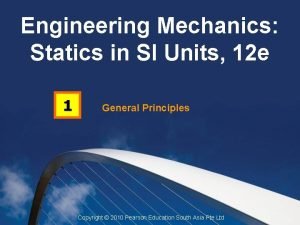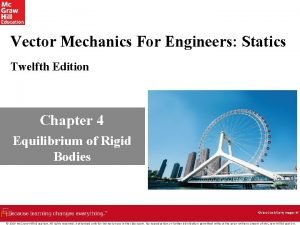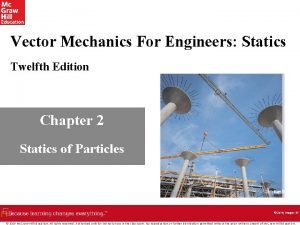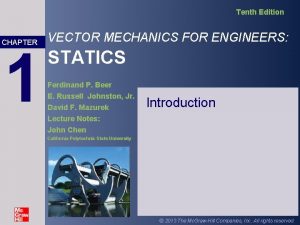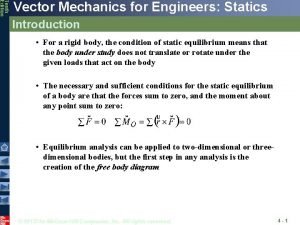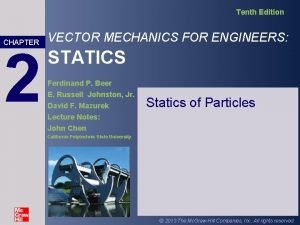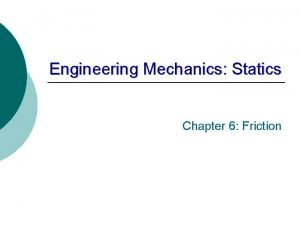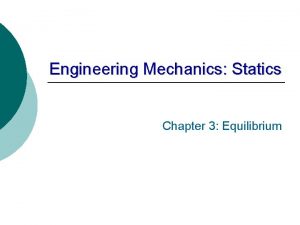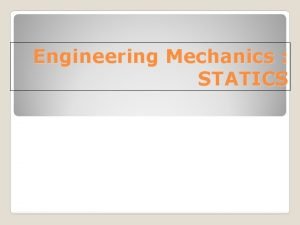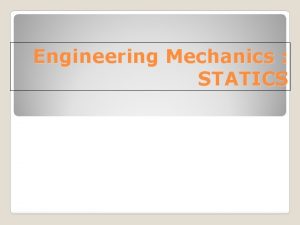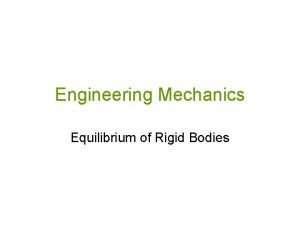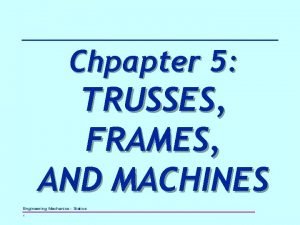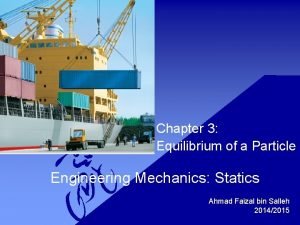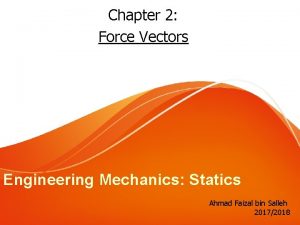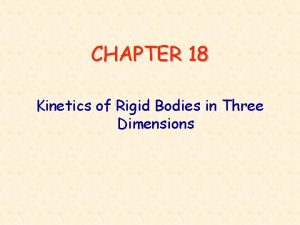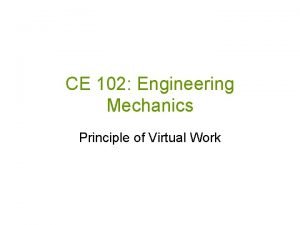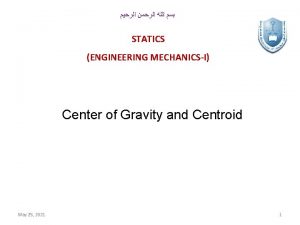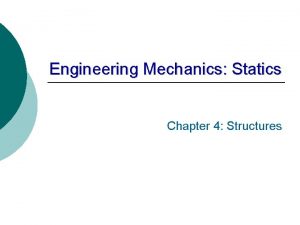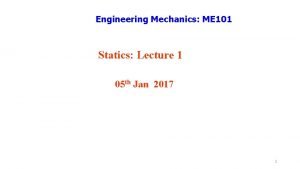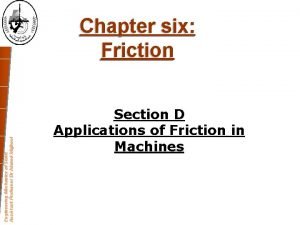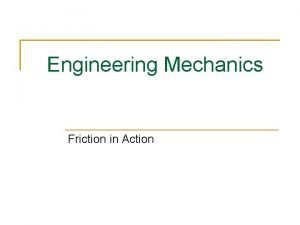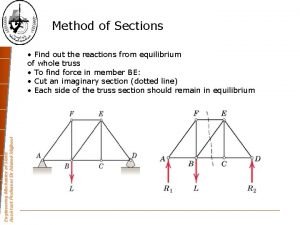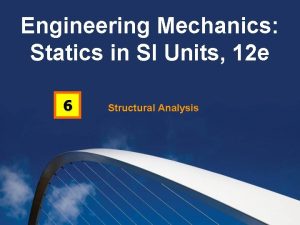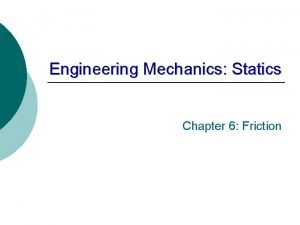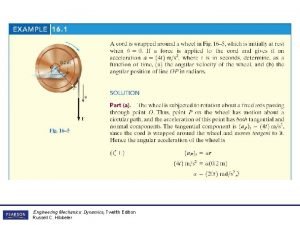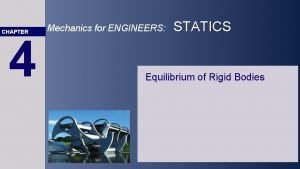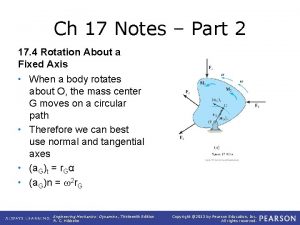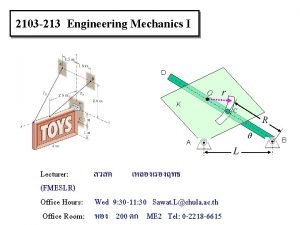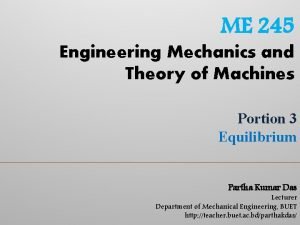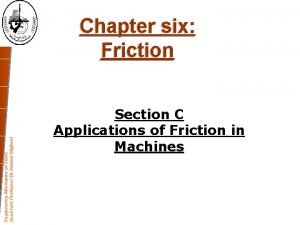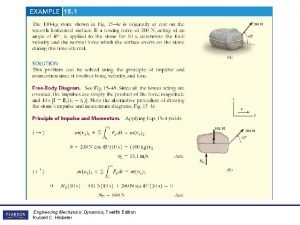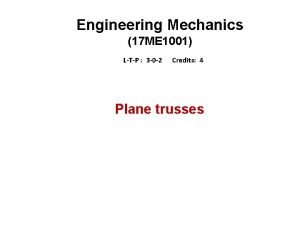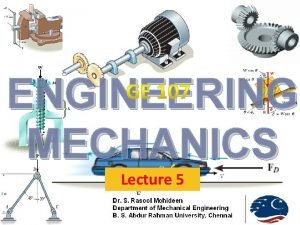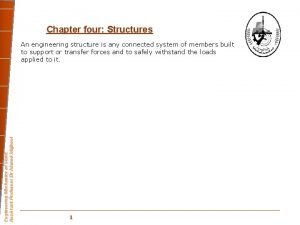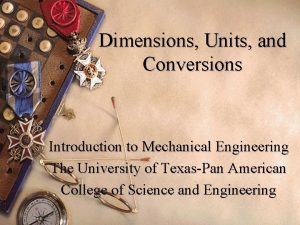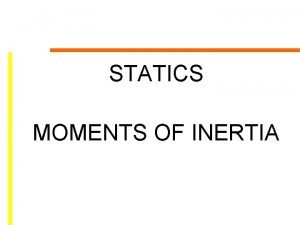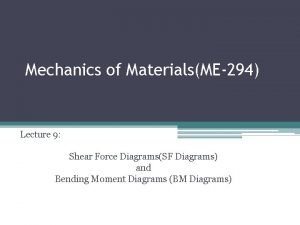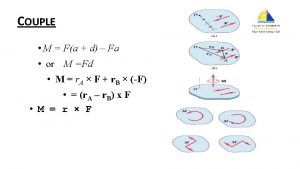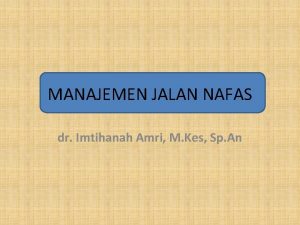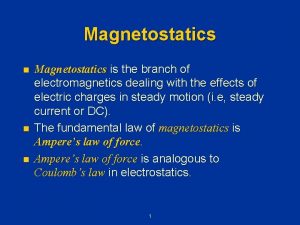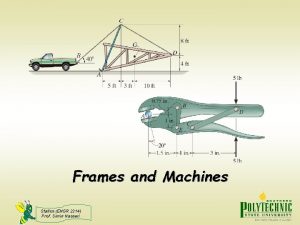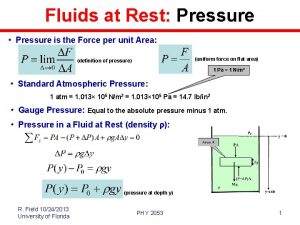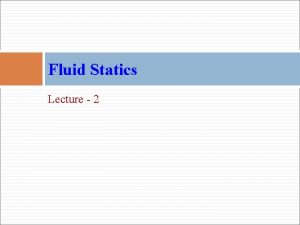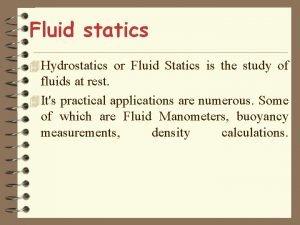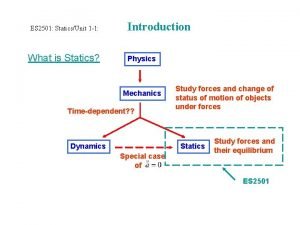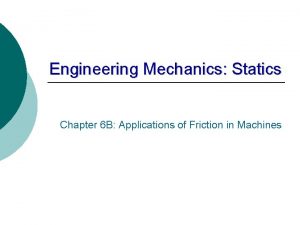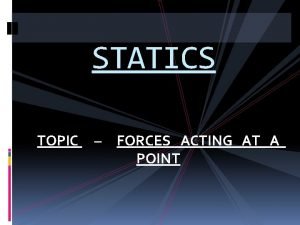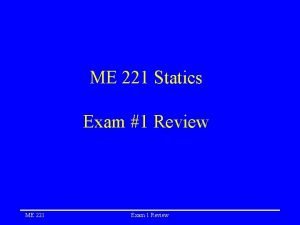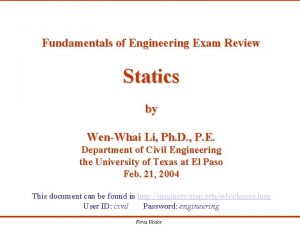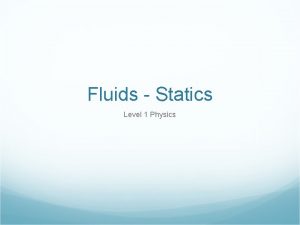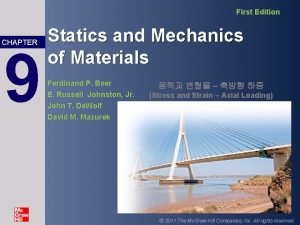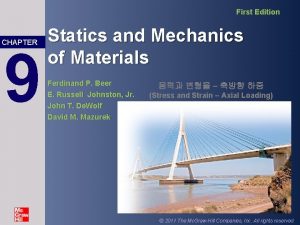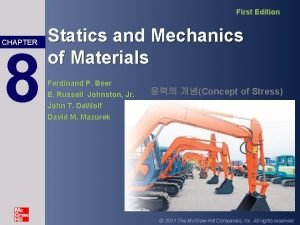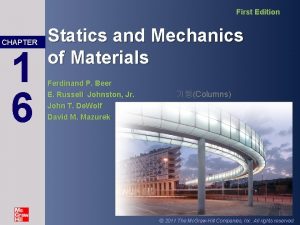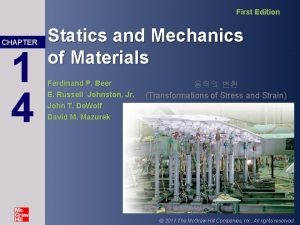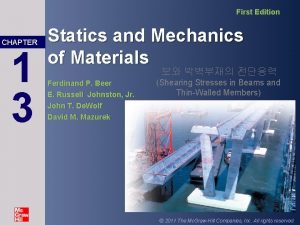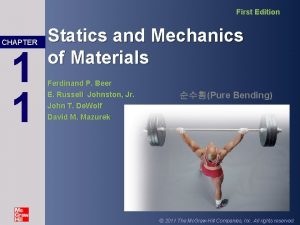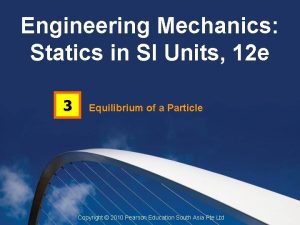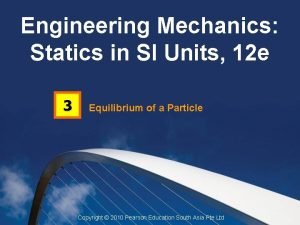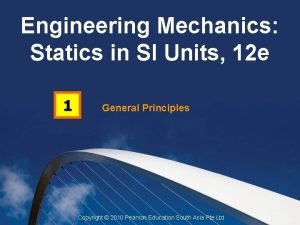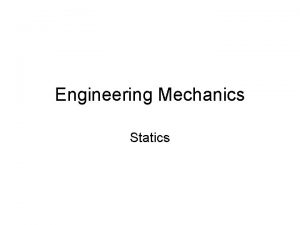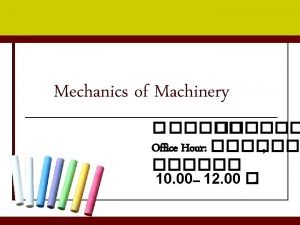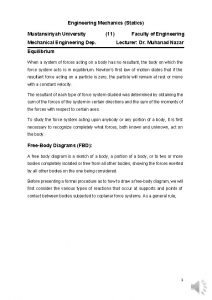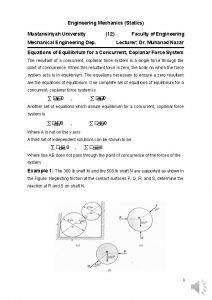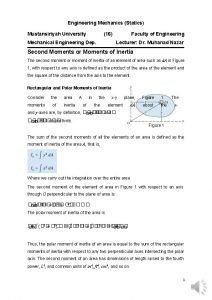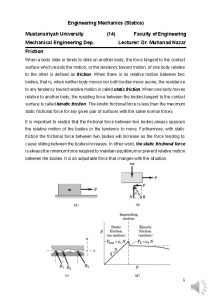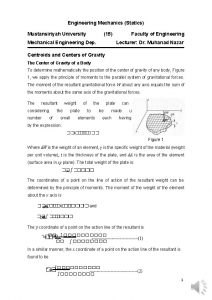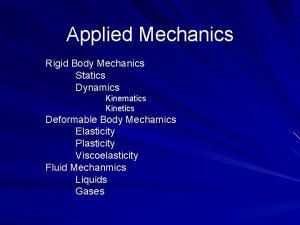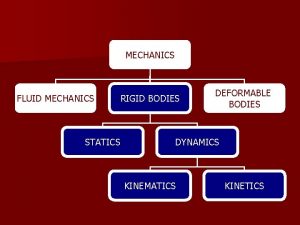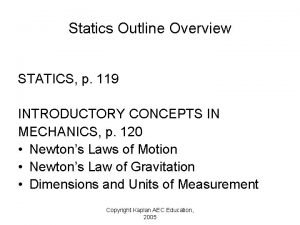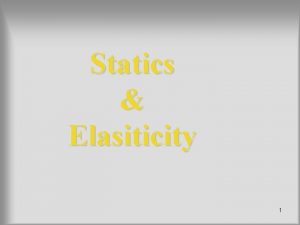Engineering Mechanics Statics in SI Units 12 e















































![Solution Position vector r = [-2 m – 1 m]i + [2 m – Solution Position vector r = [-2 m – 1 m]i + [2 m –](https://slidetodoc.com/presentation_image/a76590988fce115da488a6bf90d2fe06/image-48.jpg)



























- Slides: 75

Engineering Mechanics: Statics in SI Units, 12 e 2 Force Vectors Copyright © 2010 Pearson Education South Asia Pte Ltd

Chapter Objectives • Parallelogram Law • Cartesian vector form • Dot product and angle between 2 vectors Copyright © 2010 Pearson Education South Asia Pte Ltd

Chapter Outline 1. 2. 3. 4. 5. 6. 7. 8. 9. Scalars and Vectors Vector Operations Vector Addition of Forces Addition of a System of Coplanar Forces Cartesian Vectors Addition and Subtraction of Cartesian Vectors Position Vectors Force Vector Directed along a Line Dot Product Copyright © 2010 Pearson Education South Asia Pte Ltd

2. 1 Scalars and Vectors • Scalar – A quantity characterized by a positive or negative number – Indicated by letters in italic such as A e. g. Mass, volume and length Copyright © 2010 Pearson Education South Asia Pte Ltd

2. 1 Scalars and Vectors • Vector – A quantity that has magnitude and direction e. g. Position, force and moment – Represent by a letter with an arrow over it, – Magnitude is designated as – In this subject, vector is presented as A and its magnitude (positive quantity) as A Copyright © 2010 Pearson Education South Asia Pte Ltd

2. 2 Vector Operations • Multiplication and Division of a Vector by a Scalar - Product of vector A and scalar a = a A - Magnitude = - Law of multiplication applies e. g. A / a = ( 1/a) A, a ≠ 0 Copyright © 2010 Pearson Education South Asia Pte Ltd

2. 2 Vector Operations • Vector Addition - Addition of two vectors A and B gives a resultant vector R by the parallelogram law - Result R can be found by triangle construction - Communicative e. g. R = A + B = B + A - Special case: Vectors A and B are collinear (both have the same line of action) Copyright © 2010 Pearson Education South Asia Pte Ltd

2. 2 Vector Operations • Vector Subtraction - Special case of addition e. g. R’ = A – B = A + ( - B ) - Rules of Vector Addition Applies Copyright © 2010 Pearson Education South Asia Pte Ltd

2. 3 Vector Addition of Forces Finding a Resultant Force • Parallelogram law is carried out to find the resultant force • Resultant, FR = ( F 1 + F 2 ) Copyright © 2010 Pearson Education South Asia Pte Ltd

2. 3 Vector Addition of Forces Procedure for Analysis • Parallelogram Law – Make a sketch using the parallelogram law – 2 components forces add to form the resultant force – Resultant force is shown by the diagonal of the parallelogram – The components is shown by the sides of the parallelogram Copyright © 2010 Pearson Education South Asia Pte Ltd

2. 3 Vector Addition of Forces Procedure for Analysis • Trigonometry – Redraw half portion of the parallelogram – Magnitude of the resultant force can be determined by the law of cosines – Direction if the resultant force can be determined by the law of sines – Magnitude of the two components can be determined by the law of sines Copyright © 2010 Pearson Education South Asia Pte Ltd

Example 2. 1 The screw eye is subjected to two forces, F 1 and F 2. Determine the magnitude and direction of the resultant force. Copyright © 2010 Pearson Education South Asia Pte Ltd

Solution Parallelogram Law Unknown: magnitude of FR and angle θ Copyright © 2010 Pearson Education South Asia Pte Ltd

Solution Trigonometry Law of Cosines Law of Sines Copyright © 2010 Pearson Education South Asia Pte Ltd

Solution Trigonometry Direction Φ of FR measured from the horizontal Copyright © 2010 Pearson Education South Asia Pte Ltd

Copyright © 2010 Pearson Education South Asia Pte Ltd

Solution Copyright © 2010 Pearson Education South Asia Pte Ltd

2. 4 Addition of a System of Coplanar Forces • Scalar Notation – x and y axes are designated positive and negative – Components of forces expressed as algebraic scalars Copyright © 2010 Pearson Education South Asia Pte Ltd

2. 4 Addition of a System of Coplanar Forces • Cartesian Vector Notation – Cartesian unit vectors i and j are used to designate the x and y directions – Unit vectors i and j have dimensionless magnitude of unity ( = 1 ) – Magnitude is always a positive quantity, represented by scalars Fx and Fy Copyright © 2010 Pearson Education South Asia Pte Ltd

2. 4 Addition of a System of Coplanar Forces • Coplanar Force Resultants To determine resultant of several coplanar forces: – Resolve force into x and y components – Addition of the respective components using scalar algebra – Resultant force is found using the parallelogram law – Cartesian vector notation: Copyright © 2010 Pearson Education South Asia Pte Ltd

2. 4 Addition of a System of Coplanar Forces • Coplanar Force Resultants – Vector resultant is therefore – If scalar notation are used Copyright © 2010 Pearson Education South Asia Pte Ltd

2. 4 Addition of a System of Coplanar Forces • Coplanar Force Resultants – In all cases we have * Take note of sign conventions – Magnitude of FR can be found by Pythagorean Theorem Copyright © 2010 Pearson Education South Asia Pte Ltd

Example 2. 5 Determine x and y components of F 1 and F 2 acting on the boom. Express each force as a Cartesian vector. Copyright © 2010 Pearson Education South Asia Pte Ltd

Solution Scalar Notation Hence, from the slope triangle, we have: Cartesian Vector Notation Copyright © 2010 Pearson Education South Asia Pte Ltd

Solution By similar triangles we have Scalar Notation: Cartesian Vector Notation: Copyright © 2010 Pearson Education South Asia Pte Ltd

Example 2. 6 The link is subjected to two forces F 1 and F 2. Determine the magnitude and orientation of the resultant force. Copyright © 2010 Pearson Education South Asia Pte Ltd

Solution I Scalar Notation: Copyright © 2010 Pearson Education South Asia Pte Ltd

Solution I Resultant Force From vector addition, direction angle θ is Copyright © 2010 Pearson Education South Asia Pte Ltd

Solution II Cartesian Vector Notation F 1 = { 600 cos 30°i + 600 sin 30°j } N F 2 = { -400 sin 45°i + 400 cos 45°j } N Thus, FR = F 1 + F 2 = (600 cos 30ºN - 400 sin 45ºN)i + (600 sin 30ºN + 400 cos 45ºN)j = {236. 8 i + 582. 8 j}N The magnitude and direction of FR are determined in the same manner as before. Copyright © 2010 Pearson Education South Asia Pte Ltd

Solution II Copyright © 2010 Pearson Education South Asia Pte Ltd

2. 5 Cartesian Vectors • Right-Handed Coordinate System A rectangular or Cartesian coordinate system is said to be right-handed provided: – Thumb of right hand points in the direction of the positive z axis – z-axis for the 2 D problem would be perpendicular, directed out of the page. Copyright © 2010 Pearson Education South Asia Pte Ltd

2. 5 Cartesian Vectors • Rectangular Components of a Vector – A vector A may have one, two or three rectangular components along the x, y and z axes, depending on orientation – By two successive application of the parallelogram law A = A’ + Az A’ = Ax + Ay – Combing the equations, A can be expressed as A = Ax + Ay + Az Copyright © 2010 Pearson Education South Asia Pte Ltd

2. 5 Cartesian Vectors • Unit Vector – Direction of A can be specified using a unit vector – Unit vector has a magnitude of 1 – If A is a vector having a magnitude of A ≠ 0, unit vector having the same direction as A is expressed by u. A = A / A. So that A = A u. A Copyright © 2010 Pearson Education South Asia Pte Ltd

2. 5 Cartesian Vectors • Cartesian Vector Representations – 3 components of A act in the positive i, j and k directions A = Axi + Ayj + AZk *Note the magnitude and direction of each components are separated, easing vector algebraic operations. Copyright © 2010 Pearson Education South Asia Pte Ltd

2. 5 Cartesian Vectors • Magnitude of a Cartesian Vector – From the colored triangle, A = A '2 + Az 2 2 2 = + A ' A A – From the shaded triangle, x y – Combining the equations gives magnitude of A A = Ax 2 + Ay 2 + Az 2 Copyright © 2010 Pearson Education South Asia Pte Ltd

2. 5 Cartesian Vectors • Direction of a Cartesian Vector – Orientation of A is defined as the coordinate direction angles α, β and γ measured between the tail of A and the positive x, y and z axes – 0° ≤ α, β and γ ≤ 180 ° – The direction cosines of A is Copyright © 2010 Pearson Education South Asia Pte Ltd

2. 5 Cartesian Vectors • Direction of a Cartesian Vector – Angles α, β and can be determined by the inverse cosines Given A = Ax i + Ay j + AZ k then, u. A = A /A = (Ax /A) i + (Ay /A) j + (AZ/A) k where Copyright © 2010 Pearson Education South Asia Pte Ltd

2. 5 Cartesian Vectors • Direction of a Cartesian Vector – u. A can also be expressed as u. A = cos α i + cos β j + cos k – Since and u. A = 1, we have – A as expressed in Cartesian vector form is A = Au. A = A cos α i + A cos β j + A cos k = Ax i + Ay j + AZ k Copyright © 2010 Pearson Education South Asia Pte Ltd

2. 6 Addition and Subtraction of Cartesian Vectors • Concurrent Force Systems – Force resultant is the vector sum of all the forces in the system FR = ∑Fx i + ∑Fy j + ∑Fz k Copyright © 2010 Pearson Education South Asia Pte Ltd

Example 2. 8 Express the force F as Cartesian vector. Copyright © 2010 Pearson Education South Asia Pte Ltd

Solution Since two angles are specified, the third angle is found by cos 2 a + cos 2 b + cos 2 = 1 cos 2 a + cos 2 60 o+ cos 2 45 o = 1 2 2 cos a = 1 - (0. 5) - (0. 707 ) =± 0. 5 Two possibilities exit, namely a = cos -1 (0. 5)= 60 o Copyright © 2010 Pearson Education South Asia Pte Ltd

Solution α should be less than 90º By inspection, α = 60º since Fx is in the +x direction Given F = 200 N F = (F cos α ) i + (F cosβ ) j + (F cos ) k = (200 cos 60ºN) i + (200 cos 60ºN) j + (200 cos 45ºN) k = {100. 0 i + 100. 0 j + 141. 4 k}N Checking: Copyright © 2010 Pearson Education South Asia Pte Ltd

2. 7 Position Vectors • x, y, z Coordinates – Right-handed coordinate system – Positive z axis points upwards, measuring the height of an object or the altitude of a point – Points are measured relative to the origin, O. Copyright © 2010 Pearson Education South Asia Pte Ltd

2. 7 Position Vectors Position Vector – Position vector r is defined as a fixed vector which locates a point in space relative to another point. – e. g. r = x i + y j + z k Copyright © 2010 Pearson Education South Asia Pte Ltd

2. 7 Position Vectors Position Vector – Vector addition gives r. A + r = r. B – Solving r = r. B – r. A = (x. B – x. A) i + (y. B – y. A) j + (z. B –z. A) k or r = (x. B – x. A) i + (y. B – y. A) j + (z. B –z. A) k Copyright © 2010 Pearson Education South Asia Pte Ltd

2. 7 Position Vectors • • • Length and direction of cable AB can be found by measuring A and B using the x, y, z axes Position vector r can be established Magnitude r represent the length of cable Angles, α, β and γ represent the direction of the cable Unit vector, u = r/r Copyright © 2010 Pearson Education South Asia Pte Ltd

Example 2. 12 An elastic rubber band is attached to points A and B. Determine its length and its direction measured from A towards B. Copyright © 2010 Pearson Education South Asia Pte Ltd
![Solution Position vector r 2 m 1 mi 2 m Solution Position vector r = [-2 m – 1 m]i + [2 m –](https://slidetodoc.com/presentation_image/a76590988fce115da488a6bf90d2fe06/image-48.jpg)
Solution Position vector r = [-2 m – 1 m]i + [2 m – 0]j + [3 m – (-3 m)]k = {-3 i + 2 j + 6 k} m Magnitude = length of the rubber band Unit vector in the director of r u = r /r = -3/7 i + 2/7 j + 6/7 k Copyright © 2010 Pearson Education South Asia Pte Ltd

Solution Unit vector in the director of r u = r /r = -3/7 i + 2/7 j + 6/7 k α = cos-1(-3/7) = 115° β = cos-1(2/7) = 73. 4° = cos-1(6/7) = 31. 0° Copyright © 2010 Pearson Education South Asia Pte Ltd

2. 8 Force Vector Directed along a Line • • • In 3 D problems, direction of F is specified by 2 points, through which its line of action lies F can be formulated as a Cartesian vector F = F u = F (r/r) Note that F has units of forces (N) unlike r, with units of length (m) Copyright © 2010 Pearson Education South Asia Pte Ltd

2. 8 Force Vector Directed along a Line • • • Force F acting along the chain can be presented as a Cartesian vector by - Establish x, y, z axes - Form a position vector r along length of chain Unit vector, u = r/r that defines the direction of both the chain and the force We get F = F u Copyright © 2010 Pearson Education South Asia Pte Ltd

Example 2. 13 The man pulls on the cord with a force of 350 N. Represent this force acting on the support A, as a Cartesian vector and determine its direction. Copyright © 2010 Pearson Education South Asia Pte Ltd

Solution End points of the cord are A (0 m, 7. 5 m) and B (3 m, -2 m, 1. 5 m) r = (3 m – 0 m)i + (-2 m – 0 m)j + (1. 5 m – 7. 5 m)k = {3 i – 2 j – 6 k}m Magnitude = length of cord AB Unit vector, u = r /r = 3/7 i - 2/7 j - 6/7 k Copyright © 2010 Pearson Education South Asia Pte Ltd

Solution Unit vector, u = r /r = 3/7 i - 2/7 j - 6/7 k Force F has a magnitude of 350 N, direction specified by u. F = Fu = 350 N(3/7 i - 2/7 j - 6/7 k) = {150 i - 100 j - 300 k} N α = cos-1(3/7) = 64. 6° β = cos-1(-2/7) = 107° γ = cos-1(-6/7) = 149° Copyright © 2010 Pearson Education South Asia Pte Ltd

Solution Copyright © 2010 Pearson Education South Asia Pte Ltd

Copyright © 2010 Pearson Education South Asia Pte Ltd

2. 9 Dot Product • • • Dot product of vectors A and B is written as A·B (Read A dot B) Define the magnitudes of A and B and the angle between their tails A·B = AB cosθ where 0 ≤ θ ≤ 180° Referred to as scalar product of vectors as result is a scalar Copyright © 2010 Pearson Education South Asia Pte Ltd

2. 9 Dot Product • Laws of Operation 1. Commutative law A·B = B·A 2. Multiplication by a scalar a(A·B) = (a. A)·B = A·(a. B) = (A·B)a 3. Distribution law A·(B + D) = (A·B) + (A·D) Copyright © 2010 Pearson Education South Asia Pte Ltd

2. 9 Dot Product • Cartesian Vector Formulation - Dot product of Cartesian unit vectors i·i = (1)(1)cos 0° = 1 i·j = (1)(1)cos 90° = 0 - Similarly i·i = 1, j·j = 1, k·k = 1 i·j = 0, i·k = 0, j·k = 0 Copyright © 2010 Pearson Education South Asia Pte Ltd

2. 9 Dot Product • Cartesian Vector Formulation A·B = (Axi + Ayj + – Dot product of 2 vectors A and B Azk)(Bxi + Byj + Bzk) A·B = Ax. Bx + Ay. By + Az. Bz • Applications – The angle formed between two vectors or intersecting lines. As A·B = AB cosθ, Hence θ = cos-1 [(A·B)/(AB)] 0°≤ θ ≤ 180° – The components of a vector parallel and perpendicular to a line. Aa = A cos θ = A·u Copyright © 2010 Pearson Education South Asia Pte Ltd

Example 2. 17 The frame is subjected to a horizontal force F = {300 j} N. Determine the components of this force parallel and perpendicular to the member AB. Copyright © 2010 Pearson Education South Asia Pte Ltd

Solution (XB, YB, ZB ) = (2 m, 6 m, 3 m) Since Thus Copyright © 2010 Pearson Education South Asia Pte Ltd

Solution (Continued) Since result is a positive scalar, FAB has the same sense of direction as u. B. Express in Cartesian form Perpendicular component Copyright © 2010 Pearson Education South Asia Pte Ltd

Solution (Concluded) Magnitude can be determined from F┴ or from Pythagorean Theorem, Copyright © 2010 Pearson Education South Asia Pte Ltd

QUIZ 1. Which one of the following is a scalar quantity? A) Force B) Position C) Mass D) Velocity 2. For vector addition, you have to use ______ law. A) Newton’s Second B) the arithmetic C) Pascal’s D) the parallelogram Copyright © 2010 Pearson Education South Asia Pte Ltd

QUIZ 3. Can you resolve a 2 -D vector along two directions, which are not at 90° to each other? A) Yes, but not uniquely. B) No. C) Yes, uniquely. 4. Can you resolve a 2 -D vector along three directions (say at 0, 60, and 120°)? A) Yes, but not uniquely. B) No. C) Yes, uniquely. Copyright © 2010 Pearson Education South Asia Pte Ltd

QUIZ 5. Resolve F along x and y axes and write it in vector form. F = { ______ } N y x A) 80 cos (30°) i – 80 sin (30°) j B) 80 sin (30°) i + 80 cos (30°) j 30° C) 80 sin (30°) i – 80 cos (30°) j F = 80 N D) 80 cos (30°) i + 80 sin (30°) j 6. Determine the magnitude of the resultant (F 1 + F 2) force in N when F 1={ 10 i + 20 j }N and F 2={ 20 i + 20 j } N. A) 30 N B) 40 N C) 50 N D) 60 N E) 70 N Copyright © 2010 Pearson Education South Asia Pte Ltd

QUIZ 7. Vector algebra, as we are going to use it, is based on a ______ coordinate system. A) Euclidean B) Left-handed C) Greek D) Right-handed E) Egyptian 8. The symbols , , and designate the _____ of a 3 -D Cartesian vector. A) Unit vectors B) Coordinate direction angles C) Greek societies D) X, Y and Z components Copyright © 2010 Pearson Education South Asia Pte Ltd

QUIZ 9. What is not true about an unit vector, u. A ? A) It is dimensionless. B) Its magnitude is one. C) It always points in the direction of positive X- axis. D) It always points in the direction of vector A. 10. If F = {10 i + 10 j + 10 k} N and G = {20 i + 20 j + 20 k } N, then F + G = { ____ } N A) 10 i + 10 j + 10 k B) 30 i + 20 j + 30 k C) – 10 i – 10 j – 10 k D) 30 i + 30 j + 30 k Copyright © 2010 Pearson Education South Asia Pte Ltd

QUIZ 11. A position vector, r. PQ, is obtained by A) Coordinates of Q minus coordinates of P B) Coordinates of P minus coordinates of Q C) Coordinates of Q minus coordinates of the origin D) Coordinates of the origin minus coordinates of P 12. A force of magnitude F, directed along a unit vector U, is given by F = ______. A) F (U) B) U / F C) F / U D) F + U E) F – U Copyright © 2010 Pearson Education South Asia Pte Ltd

QUIZ 13. P and Q are two points in a 3 -D space. How are the position vectors r. PQ and r. QP related? A) r. PQ = r. QP B) r. PQ = - r. QP C) r. PQ = 1/r. QP D) r. PQ = 2 r. QP 14. If F and r are force vector and position vectors, respectively, in SI units, what are the units of the expression (r * (F / F)) ? A) Newton B) Dimensionless C) Meter D) Newton - Meter E) The expression is algebraically illegal. Copyright © 2010 Pearson Education South Asia Pte Ltd

QUIZ 15. Two points in 3 – D space have coordinates of P (1, 2, 3) and Q (4, 5, 6) meters. The position vector r. QP is given by A) {3 i + 3 j + 3 k} m B) {– 3 i – 3 j – 3 k} m C) {5 i + 7 j + 9 k} m D) {– 3 i + 3 j + 3 k} m E) {4 i + 5 j + 6 k} m 16. Force vector, F, directed along a line PQ is given by A) (F/ F) r. PQ B) r. PQ/r. PQ C) F(r. PQ/r. PQ) D) F(r. PQ/r. PQ) Copyright © 2010 Pearson Education South Asia Pte Ltd

QUIZ 17. The dot product of two vectors P and Q is defined as P A) P Q cos B) P Q sin C) P Q tan D) P Q sec Q 18. The dot product of two vectors results in a _____ quantity. A) Scalar B) Vector C) Complex D) Zero Copyright © 2010 Pearson Education South Asia Pte Ltd

QUIZ 19. If a dot product of two non-zero vectors is 0, then the two vectors must be _______ to each other. A) Parallel (pointing in the same direction) B) Parallel (pointing in the opposite direction) C) Perpendicular D) Cannot be determined. 20. If a dot product of two non-zero vectors equals -1, then the vectors must be ____ to each other. A) Parallel (pointing in the same direction) B) Parallel (pointing in the opposite direction) C) Perpendicular D) Cannot be determined. Copyright © 2010 Pearson Education South Asia Pte Ltd

QUIZ 1. The dot product can be used to find all of the following except ____. A) sum of two vectors B) angle between two vectors C) component of a vector parallel to another line D) component of a vector perpendicular to another line 2. Find the dot product of the two vectors P and Q. P = {5 i + 2 j + 3 k} m Q = {-2 i + 5 j + 4 k} m A) -12 m B) 12 m C) 12 m 2 D) -12 m 2 E) 10 m 2 Copyright © 2010 Pearson Education South Asia Pte Ltd
 Engineering mechanics: statics in si units
Engineering mechanics: statics in si units Concurrent force system
Concurrent force system Statics of rigid bodies
Statics of rigid bodies Line of action of force
Line of action of force Vector mechanics for engineers 10th edition
Vector mechanics for engineers 10th edition Mechanics
Mechanics Vector mechanics for engineers statics 10th edition
Vector mechanics for engineers statics 10th edition Vector mechanics for engineers 10th edition
Vector mechanics for engineers 10th edition Xeomin reconstitution chart
Xeomin reconstitution chart When units manufactured exceed units sold:
When units manufactured exceed units sold: Cone of friction in engineering mechanics
Cone of friction in engineering mechanics Statics chapter 3
Statics chapter 3 Engineering mechanics centroid and centre of gravity pdf
Engineering mechanics centroid and centre of gravity pdf Center of gravity statics
Center of gravity statics Free body diagram in engineering mechanics
Free body diagram in engineering mechanics Trusses and frames
Trusses and frames Particle equilibrium in 2d and 3d engineering mechanics
Particle equilibrium in 2d and 3d engineering mechanics Force vector engineering mechanics
Force vector engineering mechanics Rigid body kinetics
Rigid body kinetics Problem 2
Problem 2 Static mechanics
Static mechanics Chapter 4 statics
Chapter 4 statics Me 101 engineering mechanics
Me 101 engineering mechanics Centroid statics
Centroid statics Engineering mechanics
Engineering mechanics Belt friction formula
Belt friction formula Internal forces in structures engineering mechanics
Internal forces in structures engineering mechanics Resultant of force system
Resultant of force system Engineering mechanics
Engineering mechanics Trusses in engineering mechanics
Trusses in engineering mechanics Engineering mechanics (9th) edition chapter 12 problem 30p
Engineering mechanics (9th) edition chapter 12 problem 30p Hibbeler
Hibbeler Rocker statics
Rocker statics Engineering mechanics dynamics
Engineering mechanics dynamics Mechanics
Mechanics Engineering moments
Engineering moments Simple machines engineering mechanics
Simple machines engineering mechanics Static mechanics
Static mechanics Direct central impact
Direct central impact Engineering mechanics dynamics
Engineering mechanics dynamics Zero force members quiz online
Zero force members quiz online Dot
Dot Engineering static
Engineering static Enginnering notation
Enginnering notation Engineering dimensions and units
Engineering dimensions and units System architecture example
System architecture example Forward engineering and reverse engineering
Forward engineering and reverse engineering Dicapine
Dicapine Engineering elegant systems: theory of systems engineering
Engineering elegant systems: theory of systems engineering Reverse engineering vs forward engineering
Reverse engineering vs forward engineering Moments of inertia statics
Moments of inertia statics Rotational statics
Rotational statics Statics
Statics Shear force
Shear force Statics couples
Statics couples Statics intubasi
Statics intubasi Fundamental laws of magnetostatics
Fundamental laws of magnetostatics Machines statics
Machines statics Fluid at rest
Fluid at rest In a static fluid *
In a static fluid * Fluid statics equation
Fluid statics equation Physics mechanics
Physics mechanics Statics wedge problems
Statics wedge problems P1-p2
P1-p2 Fluid statics deals with
Fluid statics deals with Forces acting at a point in statics
Forces acting at a point in statics Statics exam 2 review
Statics exam 2 review Statics final review
Statics final review Pressure vs depth equation
Pressure vs depth equation Statics chapter 9
Statics chapter 9 Statics chapter 9
Statics chapter 9 Statics
Statics Statics
Statics 구형 압력용기 전단응력
구형 압력용기 전단응력 Statics
Statics Statics
Statics
